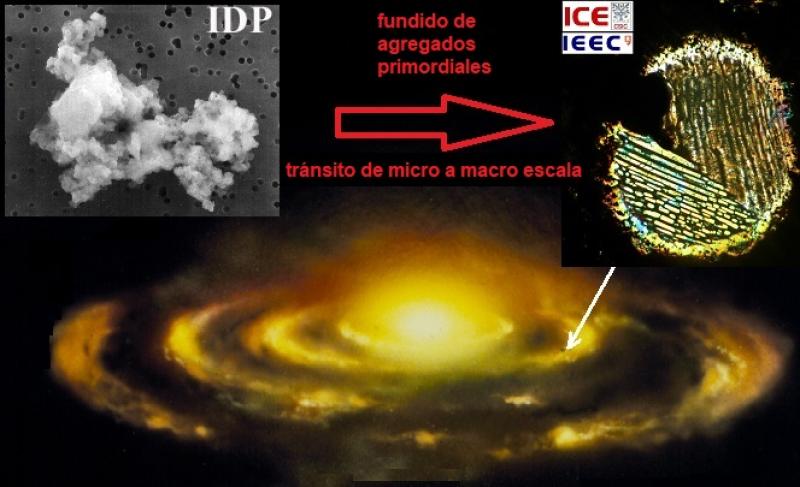New clues about the origin and collision of asteroids

These cosmic fossils contain matter from the birth of our Solar System
The meteorites might have a shared asteroid parent, but evolved differently
A recent paper published in the Monthly Notices of the Royal Astronomical Society (MNRAS) has revealed new clues about the origin and evolution of the parent asteroids of two groups of meteorites, dating back to the formation of the Solar System. These meteorites are from asteroids formed at great distances from the Sun, containing the constituent elements of planets, and are known as Carbonaceous chondrites Vigrano (CV) and Karoonda (CK).
The paper is based on the study of carbonate asteroids, so named because of their high organic matter content, which can be considered primitive because they contain solid materials that condensed around the Sun long before the Earth was formed. These asteroids are true fossils of the creation of the solid matter of our planetary system, as they cooled rapidly and their materials never melted.
A group of scientists, including Safoura Tanbakouei -former researcher of the Institute of Space Studies of Catalonia (IEEC — Institut d’Estudis Espacials de Catalunya) at the Institute of Space Sciences (ICE, CSIC)- and IEEC researcher at ICE Josep M. Trigo, have been studying the mineral content and reflective properties of these two groups of meteorites for ten years. These groups of chondrites have undergone a significant degree of metamorphism and fracture due to their exposure to collisions.
The published paper explores a scenario in which the meteorites have their origin in the same asteroid, but evolved differently as a result of an impact that generated large fragments.
 Caption: A great impact could be the origin of the disintegration of an asteroid from which fragments could arise, generating the CV and CK chondrites.
Caption: A great impact could be the origin of the disintegration of an asteroid from which fragments could arise, generating the CV and CK chondrites.
Credits: Don Dixon.
The study measures and compares the reflectance of these two groups of chondrites and points to a shared deposit from which the meteorites CV and CK evolved after one or several collisions.
According to this scenario, the CV and CK chondrites may have arisen from a common asteroid (most likely the asteroid known as Eos) that disintegrated into several fragments. Thus, due to impacts, the two groups of meteorites evolved separately.
This study concludes nearly a decade of research on Carbonaceous chondrites, as part of three projects in the Spanish plan for astronomy and astrophysics to study and recover meteorites and propose techniques for the possible future exploitation of parent asteroids.
Links
More information
This research is presented in a paper entitled “The Reflectance Spectra of CV-CK Carbonaceous chondrites from the Near Infrared to the Visible”, by S Tanbakouei, JM Trigo-Rodríguez et al., published in the Monthly Notices of the Royal Astronomical Society (MNRAS) on 30 July 2021.
The Institute of Space Studies of Catalonia (IEEC — Institut d’Estudis Espacials de Catalunya) promotes and coordinates space research and technology development in Catalonia for the benefit of society. IEEC fosters collaborations both locally and worldwide and is an efficient agent of knowledge, innovation and technology transfer. As a result of 25 years of high-quality research, done in collaboration with major international organisations, IEEC ranks among the most noted international research centers, focusing on areas such as: astrophysics, cosmology, planetary science, and Earth Observation. IEEC’s engineering division develops instrumentation for ground- and space-based projects, and has extensive experience in working with private or public organisations from the aerospace and other innovation sectors.
IEEC is a private non-profit foundation, governed by a Board of Trustees composed of Generalitat de Catalunya and four other institutions that each have a research unit, which together constitute the core of IEEC R&D activity: the University of Barcelona (UB) with the research unit ICCUB — Institute of Cosmos Sciences; the Autonomous University of Barcelona (UAB) with the research unit CERES — Center of Space Studies and Research; the Polytechnic University of Catalonia (UPC) with the research unit CTE — Research Group in Space Sciences and Technologies; the Spanish Research Council (CSIC) with the research unit ICE — Institute of Space Sciences. IEEC is a CERCA (Centres de Recerca de Catalunya) center.
Contacts
IEEC Communication Office
Barcelona, Spain
Sònia Bagudanch
E-mail: comunicacio@ieec.cat
Contact researcher
Barcelona, Spain
Josep M. Trigo
Institute of Space Sciences (ICE, CSIC)
E-mail: trigo@ice.csic.es
